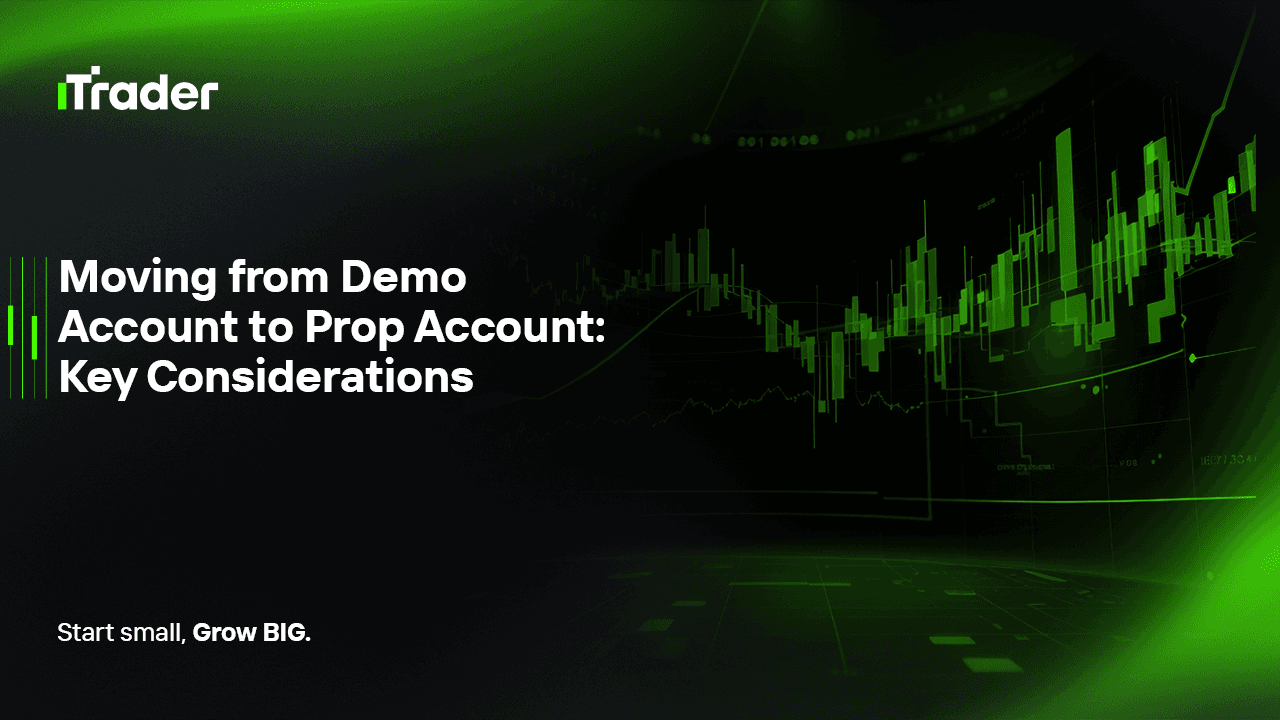2025-09-16
For most aspiring forex traders, the journey begins on a demo account. It’s a safe environment where mistakes cost nothing, strategies can be tested freely, and confidence can be built without the pressure of real money. But at some point, every trader faces the big leap — moving from demo to a prop account, where real capital is on the line and strict rules apply.

This transition isn’t just about proving your technical skills. Prop firms evaluate traders on much deeper levels: risk management, discipline, psychological resilience, and consistency. Passing this phase means showing that you can handle not only the charts but also the emotions, rules, and capital entrusted to you.
In this blog, we’ll break down what you should pay close attention to when making this critical shift, and how to prepare for success in a prop firm environment.
On the surface, demo and prop accounts look similar — you open trades, watch price movements, and manage positions. But the dynamics are very different:
Understanding these differences upfront is essential because many traders stumble not due to lack of skill but due to underestimating the psychological and structural changes.
A demo account is not just for testing whether a strategy “works.” It’s where you build the habits that will carry you through prop challenges. Before attempting a prop account, ensure you’ve:
Think of demo as your rehearsal stage. You don’t pass to the main show (prop account) until you can consistently perform on this smaller stage.
The biggest hurdle in moving from demo to prop is not technical but psychological. When money is real (even if it’s the firm’s), your brain reacts differently:
To manage this shift, you must prepare mentally as much as you prepare technically.
Prop firms don’t care if you make 20% profit in a week. They care if you can protect capital while generating returns. That’s why risk management takes center stage:
In fact, most prop firms would rather see a trader earn 5% with tight drawdowns than 15% with reckless exposure.
The goal in a prop challenge is not to prove you’re a genius trader — it’s to demonstrate you’re a reliable, consistent risk manager. Here’s how to approach it:
Remember: Prop firms are evaluating how you’d handle their money long-term, not just whether you can hit a short-term profit goal.
Moving from demo to prop should not be impulsive. A structured transition plan increases your odds of success:
This staged approach prevents emotional burnout and builds confidence step by step.
Many traders fail prop challenges not because they lack skill, but because they repeat avoidable mistakes:
Awareness of these pitfalls can help you sidestep them.
The demo account is your training ground. The prop account is your audition. Passing it successfully is not the end goal — it’s the beginning of your professional career.
Think of it as stages:
Each stage builds on the previous one. Skipping steps or rushing leads to failure, while gradual mastery leads to long-term success.
Transitioning from demo to prop is one of the most challenging and important steps in a trader’s journey. The skills that served you well on demo — strategy testing, execution practice, risk calculation — now must be reinforced with discipline, emotional control, and strict adherence to rules.
To succeed, remember:
If you respect the process, master your emotions, and trade with consistency, you’ll not only pass prop challenges but also position yourself as a trader capable of long-term growth and professional success.
© 2025 iTrader Global Limited | Số đăng ký công ty: 15962
iTrader Global Limited có trụ sở tại Hamchako, Mutsamudu, Đảo tự trị Anjouan, Liên bang Comoros và được cấp phép, quản lý bởi Ủy ban Chứng khoán Comoros. Giấy phép số: L15962/ITGL.
iTrader Global Limited hoạt động dưới tên thương mại “iTrader” và được cấp quyền thực hiện các hoạt động giao dịch ngoại hối. Logo, thương hiệu và trang web của công ty là tài sản độc quyền của iTrader Global Limited.
Các công ty con khác của iTrader Global Limited bao gồm: iTrader Global Pty Ltd, số đăng ký công ty tại Úc (ACN): 686 857 198. Công ty này là đại diện được ủy quyền (số đại diện AFS: 001315037) của Opheleo Holdings Pty Ltd (giấy phép dịch vụ tài chính Úc AFSL: 000224485), có địa chỉ đăng ký tại: Tầng 1, số 256 đường Rundle, Adelaide, SA 5000.
Tuyên bố miễn trừ trách nhiệm: Công ty này không phải là tổ chức phát hành và không chịu trách nhiệm đối với các sản phẩm tài chính được giao dịch trên hoặc thông qua trang web này.
Cảnh báo rủi ro: Giao dịch CFD có mức độ rủi ro cao do đòn bẩy và có thể dẫn đến mất vốn nhanh chóng, không phù hợp với tất cả người dùng.
Giao dịch quỹ, CFD và các sản phẩm có đòn bẩy cao khác đòi hỏi kiến thức chuyên môn.
Nghiên cứu cho thấy 84,01% nhà giao dịch sử dụng đòn bẩy bị thua lỗ. Hãy đảm bảo rằng bạn hiểu rõ rủi ro và sẵn sàng chấp nhận mất toàn bộ số vốn trước khi giao dịch.
iTrader tuyên bố rằng họ sẽ không chịu trách nhiệm đầy đủ đối với bất kỳ rủi ro, tổn thất hoặc thiệt hại nào phát sinh từ hoạt động giao dịch có đòn bẩy, dù là đối với cá nhân hay pháp nhân.
Hạn chế sử dụng: iTrader không cung cấp trang web hoặc dịch vụ cho cư dân tại các quốc gia nơi hoạt động này bị cấm bởi pháp luật, quy định hoặc chính sách.